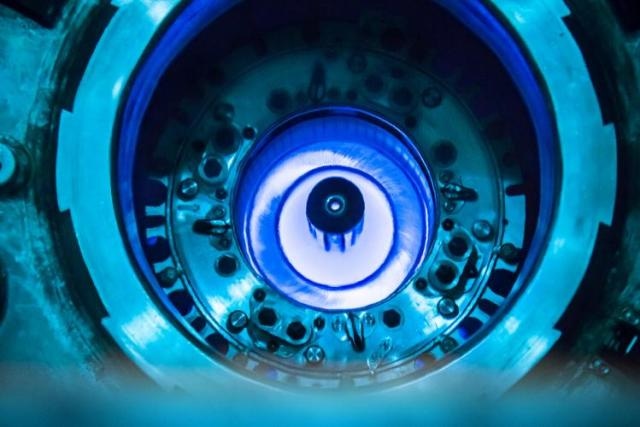Jun 21 2016
An experiment to discover new physics associated with neutrinos is to be deployed in the Department of Energy’s Oak Ridge National Laboratory.
 The High Flux Isotope Reactor, a Department of Energy Office of Science User Facility that creates continuous neutron beams, is the site of a new neutrino experiment. Yale-led PROSPECT will probe neutrinos formed as a byproduct of radioactive decay processes. (Image credit- Oak Ridge National Laboratory, U.S. Dept. of Energy; photographer Genevieve Martin)
The High Flux Isotope Reactor, a Department of Energy Office of Science User Facility that creates continuous neutron beams, is the site of a new neutrino experiment. Yale-led PROSPECT will probe neutrinos formed as a byproduct of radioactive decay processes. (Image credit- Oak Ridge National Laboratory, U.S. Dept. of Energy; photographer Genevieve Martin)
Yale University leads the Precision Oscillation and Spectrum Experiment, or PROSPECT, and it includes associates from 14 academic and governmental institutions. The experiment at the High Flux Isotope Reactor (HFIR), a DOE Office of Science User Facility at ORNL, would be supported by the DOE High Energy Physics program. The neutrino is a subject of a 2015 Nobel Prize and remains as an inadequately understood basic particle of the Standard Model of particle physics.
These electrically neutral subatomic particles are produced as a side product of radioactive decay processes in nuclear reactors and stars. They interact with other matter through weak forces, rendering difficulty in their detection. Due to this elusiveness, neutrinos are the focus of numerous exciting and challenging detection experiments, as well as PROSPECT.
Unique capabilities of ORNL will enable us to broaden the understanding of neutrino properties. The expansion of neutrino experiments at Oak Ridge National Laboratory is a win for the lab because we have a new scientific focus area, and a win for the scientific community because ORNL has unique neutrino sources that physicists will utilize to explore neutrino science.
David Dean, Director of ORNL’s Physics Division
The two DOE Office of Science User Facilities for neutron scattering also generate an abundant supply of neutrinos as a byproduct, apart from neutrons. The Spallation Neutron Source, which sends pulsed neutron beams, and HFIR, which supplies continuous neutron beams are the two sources. PROSPECT would be HFIR’s first experiment to detect neutrinos that are emitted from the reactor.
The PROSPECT experiment has 68 associates, including 14 from ORNL, and has been in development for more than 3 years. Researchers would extract information regarding neutrino oscillations—transmutations of electron neutrino, muon neutrino and tau neutrino “flavors” from one to another. Specifically, researchers want to determine if neutrino oscillations take place over short distances (less than 65 ft). At these short distances, neutrino oscillations have not been observed. Observing neutrino oscillations at these distances, together with PROSPECT’s other objectives of high-precision measurements of the neutrino flux and spectrum from HFIR, can disclose the existence of a fourth neutrino flavor that does not interact by means of the weak force, a “sterile neutrino.” This new particle can be viewed by revising the Standard Model, which elucidates about elementary particles and the forces governing them.
Selecting the location of PROSPECT was competitive; HFIR and other U.S. research reactor sites were analyzed.
We have been working for over three years to ensure that the experiment is located at HFIR.
Chris Bryan, HFIR
These efforts include installing a 30-ton shielded detector system in an operating research reactor building located 21 ft near the reactor core without influencing HFIR’s initial missions of isotope production, neutron scattering research and irradiated materials testing.
“We have been actively engaged with ORNL’s Physics Division, the first line for data gathering as well as ongoing care of the neutrino detector at HFIR,” he said.
Physicist Alfredo Galindo-Uribarri, who was also the ORNL-site principal investigator for the project, said reviewers found that HFIR was the best reactor for short-baseline physics.
As one of the best-studied reactors, its behavior is very well understood,” he explained. “The research reactor has the most compact core of any reactor and burns highly enriched uranium. The fission products decay to form neutrinos. Particles start out as electron neutrinos and then change to muon and tau forms.
Alfredo Galindo-Uribarri, Physicist, ORNL
Reactor neutrino detection at HFIR requires a thorough understanding of background radiation fields. ORNL researchers have been working on detailed measurements to comprehend the background production sources at HFIR and show that reactor-produced neutron backgrounds can be repressed with sensibly chosen shielding material.
Researchers would place a 15-ft-high movable detector near the reactor. To detect the flash produced when a neutrino unites with a proton to form a neutron and a positron (or anti-electron), the researchers would fill the detector with 3 tons of liquid scintillator. At ORNL a model detector has been constructed for analysis in preparation of the arrival of PROSPECT’s detection instrument, currently being constructed at Yale. That instrument would be installed at ORNL’s research reactor before data collection starts next year.
ORNL's associates on PROSPECT are George Barclay, John Cunningham, Geoffrey Deichert, Robert Varner, Michael Febbraro, Blaine Heffron, Brennan Hackett, Charlie Havener, Paul Mueller, Elisa Romero-Romero, Chris Bryan, James Matta, David Dean and Alfredo Galindo-Uribarri.
PROSPECT’s partners apart from Yale and ORNL are Drexel University, Georgia Institute of Technology, Le Moyne College, Illinois Institute of Technology, University of Waterloo, National Institute of Standards and Technology, University of Tennessee–Knoxville, Brookhaven National Laboratory, College of William and Mary, Temple University, Lawrence Livermore National Laboratory and University of Wisconsin–Madison.
ORNL is managed by UT-Battelle for DOE’s Office of Science. The Office of Science is the single biggest supporter of basic research in the physical sciences in the United States that is working to tackle some of the major pressing challenges.